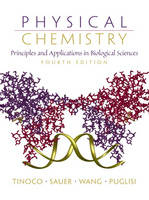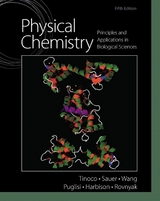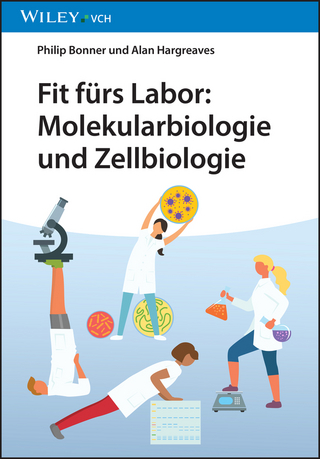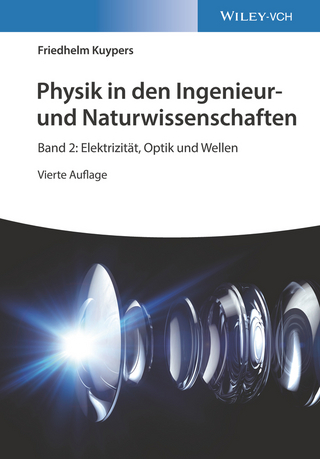
Physical Chemistry
Pearson (Verlag)
978-0-13-095943-0 (ISBN)
- Titel erscheint in neuer Auflage
- Artikel merken
For a one/two-term course in Physical Chemistry for students in the biological sciences.
This best-selling text presents the principles and applications of contemporary physical chemistry as they are used to solve problems in biology, biochemistry, and medicine. This text puts the study of physical chemistry for these students in context. Each chapter starts with sections on concepts and applications. These provide students with an overview of the physical chemistry principle under discussion and how that topic can be applied to solving biological and biochemical problems.
Ignacio Tinoco was an undergraduate at the University of New Mexico, a graduate student at the University of Wisconsin, and a postdoctoral fellow at Yale. He then went to the University of California, Berkeley, where he has remained. His research interest has been on the structures of nucleic acids, particularly RNA. He was chairman of the Department of Energy committee that recommended in 1987 a major initiative to sequence the human genome. His present research is on unfolding single RNA molecules by force. Kenneth Sauer grew up in Cleveland, Ohio, and received his A.B. in chemistry from Oberlin College. Following his Ph.D. studies in gas-phase physical chemistry at Harvard, he spent three years teaching at the American University of Beirut, Lebanon. A postdoctoral opportunity to learn from Melvin Calvin about photosynthesis in plants led him to the University of California, Berkeley, where he has been since 1960. Teaching general chemistry and biophysical chemistry in the Chemistry Department has complemented research in the Physical Biosciences Division of the Lawrence Berkeley National Lab involving spectroscopic studies of photosynthetic light reactions and their role in water oxidation. His other activities include reading, renaissance and baroque choral music, canoeing, and exploring the Sierra Nevada with his family and friends. James C. Wang was on the faculty of the University of California, Berkeley, from 1966 to 1977. He then joined the faculty of Harvard University, where he is presently Mallinckrodt Professor of Biochemistry and Molecular Biology. His research focuses on DNA and enzymes that act on DNA, especially a class of enzymes known as DNA topoisomerases. He has taught courses in biophysical chemistry and molecular biology and has published over 200 research articles. He is a member of Academia Sinica, the American Academy of Arts and Sciences, and the U.S. National Academy of Sciences. Joseph Puglisi was born and raised in New Jersey. He received his B.A. in chemistry from The Johns Hopkins University in 1984 and his Ph.D. from the University of California, Berkeley, in 1989. He has studied and taught in Strasbourg, Boston, and Santa Cruz, and is currently professor of structural biology at Stanford University. His research interests are in the structure and mechanism of the ribosome and the use of NMR spectroscopy to study RNA structure. He has been a Dreyfus Scholar, Sloan Scholar, and Packard Fellow.
(NOTE: Most chapters begin with Concepts and Applications and end with Summary, References, Suggested Readings and Problems.)
Preface.
About the Authors.
1. Introduction.
The Human Genome and Beyond. Transcription and Translation. Ion Channels.
2. The First Law: Energy Is Conserved.
Energy Conversion and Conservation. Describing the State of a System. Phase Changes. Chemical Reactions. Molecular Interpretations of Energy and Enthalpy. Mathematics Needed for Chapter 2.
3. The Second Law: The Entropy of the Universe Increases.
Historical Development of the Second Law: The Carnot Cycle. A New State Function, Entropy. The Second Law of Thermodynamics: Entropy Is Not Conserved. Molecular Interpretation of Entropy. Measurement of Entropy. Chemical Reactions. Third Law of Thermodynamics. Gibbs Free Energy. Helmholtz Free Energy. Noncovalent Reactions. Use of Partial Derivatives in Thermodynamics.
4. Free Energy and Chemical Equilibria.
Chemical Potential (Partial Molar Gibbs Free Energy). Reactions of Gases: The Ideal Gas Approximation. Nonideal Systems. The Equilibrium Constant and the Standard Gibbs Free Energies of the Reactants and Products. Galvanic Cells. Biochemical Applications of Thermodynamics. Mathematics Needed for Chapter 4.
5. Free Energy and Physical Equilibria.
Phase Equilibria. Membranes. Active and Passive Transport. Colligative Properties. Molecular-Weight Determination. Internet.
6. Molecular Motion and Transport Properties.
Kinetic Theory. Molecular Collisions. Mean Free Path. Diffusion. Sedimentation. Determination of Molecular Weights from Sedimentation and Diffusion. Viscosity. Electrophoresis. Size and Shape of Macromolecules.
7. Kinetics: Rates of Chemical Reactions.
Kinetics. Reaction Mechanisms and Rate Laws. Temperature Dependence. Transition-State Theory. Electron Transfer Reactions: Marcus Theory. Ionic Reactions and Salt Effects. Isotopes and Stereochemical Properties. Very Fast Reactions. Diffusion-Controlled Reactions. Photochemistry and Photobiology. Photosynthesis. Mathematics Needed for Chapter 7.
8. Enzyme Kinetics.
Enzyme Kinetics. Michaelis-Menten Kinetics. Competition and Inhibition. Mathematics Needed for Chapter 8.
9. Molecular Structures and Interactions: Theory.
The Process of Vision. Origins of Quantum Theory. Quantum Mechanical Calculations. Schrodinger's Equation. Particle in a Box. Tunneling. Simple Harmonic Oscillator. Rigid Rotator. Hydrogen Atom. Electron Distribution. Molecular Structure and Molecular Orbitals. Intermolecular and Intramolecular Forces. Noncovalent Interactions. Molecular Dynamics Simulation. Outlook. Schrodinger's Equation. Some Useful Operators. Mathematics Needed for Chapter 9.
10. Molecular Structures and Interactions: Spectroscopy.
Electromagnetic Spectrum. Color and Refractive Index. Absorption and Emission of Radiation. Proteins and Nucleic Acids: Ultraviolet Absorption Spectra. Fluorescence. Optical Rotatory Dispersion and Circular Dichroism. Circular Dichroism of Nucleic Acids and Proteins. Vibrational Spectra, Infrared Absorption, and Raman Scattering. Nuclear Magnetic Resonance. Interactions in Nuclear Magnetic Resonance.
11. Molecular Distributions and Statistical Thermodynamics.
Binding of Small Molecules by a Polymer. The Random Walk. Helix-Coil Transitions. Statistical Thermodynamics. Mathematics Needed for Chapter 11.
12. Macromolecular Structure and X-Ray Diffraction.
Visible Images. X Rays. Determination of Molecular Structure. Electron Diffraction. Neutron Diffraction. Electron Microscopy. Mathematics Needed for Chapter 12.
Appendix.
Answers.
Index.
| Erscheint lt. Verlag | 31.8.2001 |
|---|---|
| Sprache | englisch |
| Maße | 209 x 255 mm |
| Gewicht | 1580 g |
| Themenwelt | Naturwissenschaften ► Biologie ► Allgemeines / Lexika |
| Naturwissenschaften ► Chemie ► Physikalische Chemie | |
| ISBN-10 | 0-13-095943-X / 013095943X |
| ISBN-13 | 978-0-13-095943-0 / 9780130959430 |
| Zustand | Neuware |
| Informationen gemäß Produktsicherheitsverordnung (GPSR) | |
| Haben Sie eine Frage zum Produkt? |
aus dem Bereich



